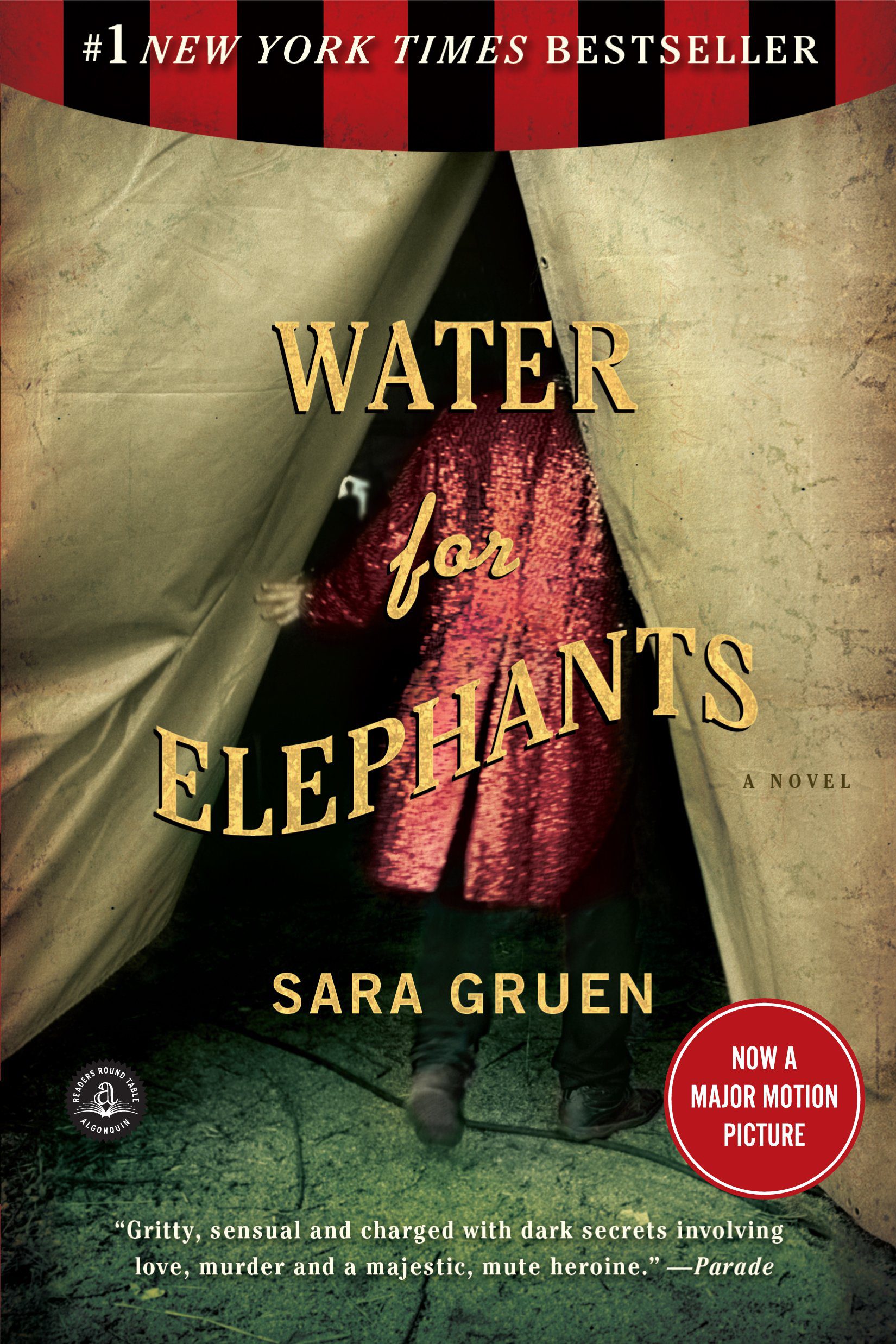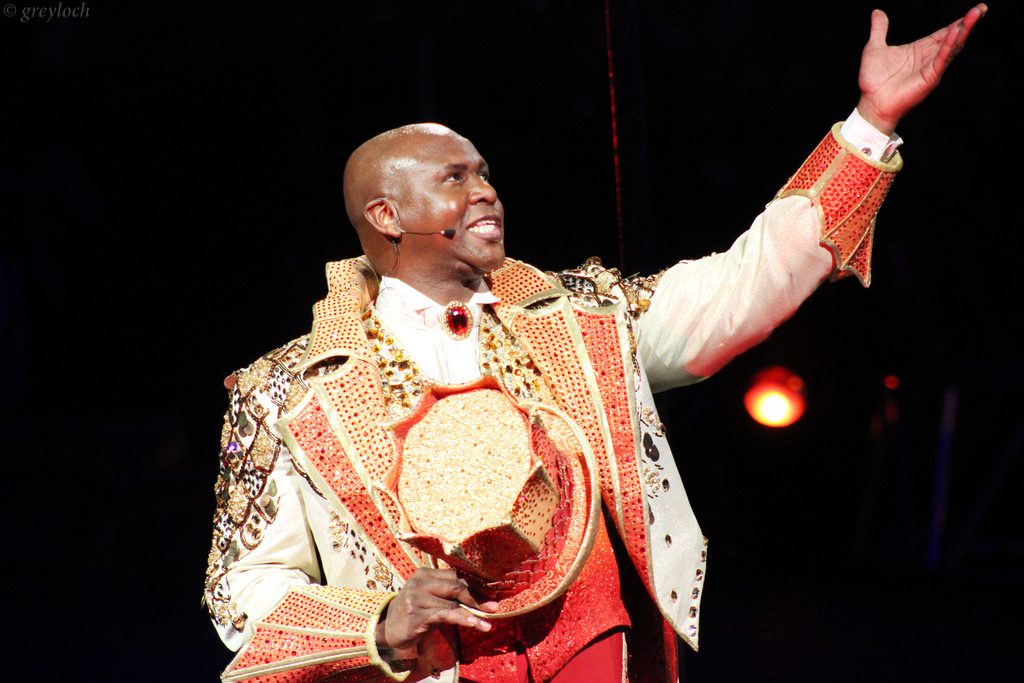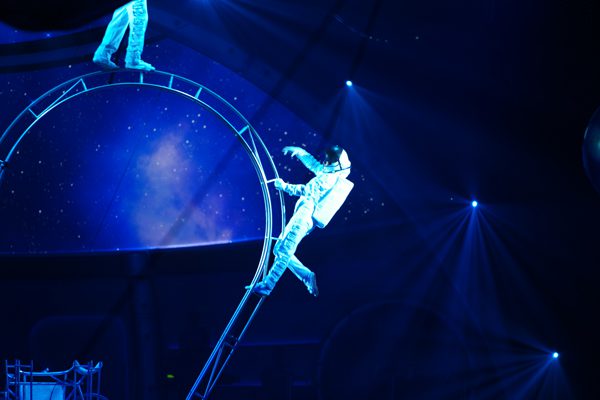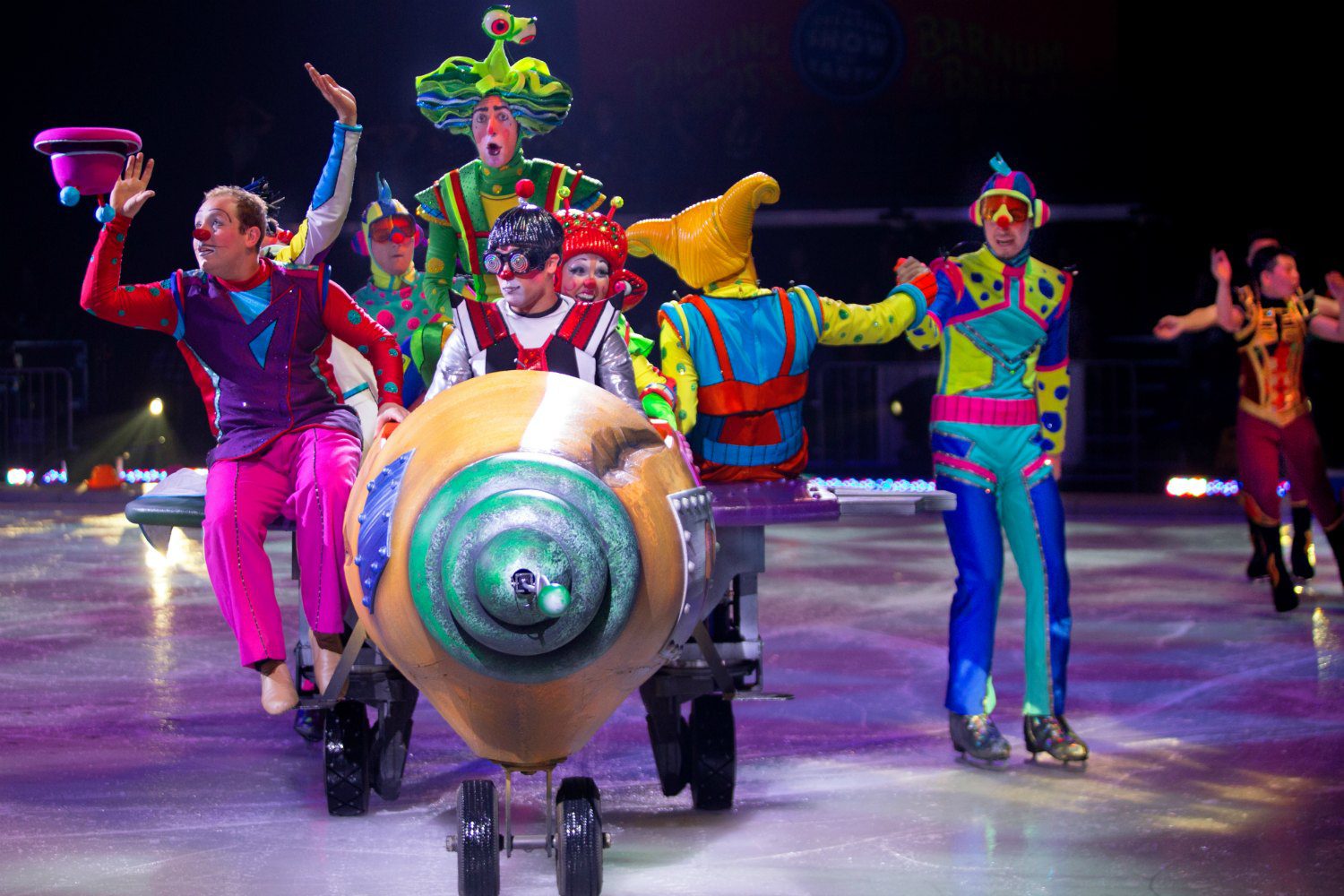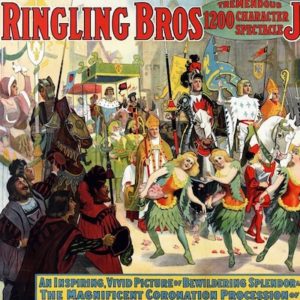
As of early 2017, it may have still been possible to run away and join the circus. This promise (or is it a threat?) could take a while to fade from popular usage, like “holding your horses” or declaring passionate love for someone via a mixed tape. But now that Ringling Bros. and Barnum & Bailey is dissolving after nearly one hundred and fifty years, it feels too late to jump on the circus train, which has already left the station where symbolic life choices originate.
This news doesn’t affect me, personally—I was never really a circus fan—but it fills me with the sinking feeling that the era we are about to enter is full of holes. And because I love last chances, I attended one of the final Ringling Bros. and Barnum & Bailey shows, Out Of This World™, alongside Philadelphia ladies and gentleman, boys and girls, and children of all ages. Behind me, a solo man warmed up his vocal chords for the stream of low-volume heckling he’d keep up, like a meditation chant, for the whole show. In front of me, a woman in a fur coat tried to take a picture of her rainbow-colored Slurpee and ended up kicking the whole thing over.
It’s no mystery why the Ringling Bros. and Barnum & Bailey Circus is no longer sustainable. Old-school, animal-centric productions are now repugnant to anyone who read Water for Elephants or saw the movie. In response to criticism from animal rights groups, Ringling Bros. retired their elephants in 2015, but if anything, that sealed the company’s fate, since their remaining fans were clearly still okay with or ignorant about pachyderm abuse and may even have regarded elephants as a personal spirit animal, the beasts they came to see. Also, as my mom put it, it’s possible to be done with the circus, and not need it anymore. Its bones and metaphysical feats, are, like a Catholic mass, pretty much the same every time. And yet, given that 2017 was turning out to be brazenly, stupidly bizarre, and it was only February, I felt that a little familiarity couldn’t hurt—an unusual urge, since the circus is supposed to distort your reality for an hour or two.
In other words, something’s wrong when you turn to acrobats and lion tamers to anchor yourself in a spinning world.
In an October 2016 Huffington Post article, Out Of This World’s ringmaster, Johnathan Lee Iverson, condemned the use of circus as a metaphor for political messes. He wrote, “Circus is not laissez-faire. You can’t phone it in and hope to skirt by on charm or shock value.” The circus only gives the impression of a rampant individualist trying to assert his dominance over three rings of chaos; it’s actually an intricate network of special interest groups: trapeze artists, Cassock riders, motocross daredevils, acrobatic skaters, all bringing lifetimes of knowledge to the art of flaunting their bodies without brutally clotheslining each other. And while the circus can feel dynastic (Victor Rossi, from Monte Carlo, states in his bio that he’s a “Clown born of clowns, who were born of clowns, who were born of clowns…,”) it makes room for first-generation performers like Mandy Curry, a strawberry-nosed clown who got her start in small-town church shows, and the King Charles Troupe, basketball-playing unicyclists from the southeast Bronx.
George Washington was a circus aficionado. As a skilled horseman himself, he admired the risky but disciplined equestrian performances that were the mainstays of early productions, like John Bill Ricketts’s at the corner of 12th and Market Streets in Philadelphia. Ricketts sometimes accompanied the president on rides in the countryside, and was painted by Gilbert Stuart, Washington’s portraitist. When Ricketts danced a Scottish hornpipe on his horse’s spine or juggled oranges while riding backwards, what looked like whimsy was the gilding on a frame of deep expertise: the kind that contained both the past and future within it. This expertise, imbuing acts with metaphorical potential regardless of their outcome, is a sliver of what’s missing from the ongoing spectacle of the Trump administration. To believe in the leadership of a Ringmaster Trump is to lose oneself in a one-man show of murky internal logic: an inward-facing performance that trips over itself, then declares the fall intentional. Such a closed-circuit production leaves little room for imaginative growth, and in Trump’s narrow and ungenerous rendering of the world, there is nothing to take away, nothing to build on.
The circus, on the other hand, has always faced outward. In the early 1800s, American circuses evolved from European-style productions run out of elegant, permanent buildings, as Paris’s Cirque d’Hiver still is, to larger traveling tent shows complete with menageries, freak shows, and multiple rings. Compact hometowns went fuzzy at the edges when the circus rolled in. Audiences were drawn to the vaulted tent, its whirling center. If you were someone whose thinking had stiffened from years of performing the same work, maybe you acquired new fantasies: oh, to be a fire-eater! If you were a kid in sore need of prescription glasses, you saw the bright blurs of what you’d been missing all along.
I had to remind myself not to watch my last circus through rose-colored lenses. Feld Entertainment, which acquired Ringling Bros. and Barnum & Bailey in 1967, is the same company that produces Disney on Ice; the cost of taking a family to this show ranges from uncomfortable to absurd, depending on where you’re sitting. But it seemed reasonable to isolate the performers from the producers, granting each spectacle the grace of existing for its own sake. And though I’d spent twenty bucks to park next to a truck still plastered with a Make America Great Again bumper sticker outside Philadelphia’s Wells Fargo Center, once I got inside I felt I’d entered a sanctum (albeit, one with digital billboards) where bodies flexed in label-less leotards and our forty-fifth president felt light years away.
I’d gotten a discount ticket from the university where I teach and was amazed to find myself in the best seat of my life. Unlike the nosebleed sections of my childhood, from which tigers were kittens, this seat was close enough that the Royal Bengals in the pre-show had mass, texture, and meat breath, though that last bit might have been an audience member’s dinner. (Proximate smells can sync up with the contents of a production itself, contributing to a state of suspended disbelief in which operatic singing smells a lot like Chanel No. 5, and a whiff of cheesesteak stands in for the ounce of partially decomposed civility smoothing the bonds between human and big cat. It’s all part of the show.)
Eventually, Rutgers undergraduates on awkward dates filled the rest of my row, some women dressed in tinfoil-y uniforms urged everyone to download the official circus app, and a huge digital control panel counted down to blastoff, after which we were all launched into interstellar space: perhaps the only logical direction to go, now that Ringling Bros. was at the end of its tether. The show started off quietly with the Simet Troupe’s Giant Semaphore: a petal-shaped metal ring that rotated while two astronauts toed its orbit. Later, this couple peddled a bike, slo-mo, along the Semaphore’s rising action while a third astronaut served as dangling counterweight. Planet Earth glowed in a corner—a spotlit disco ball, alive with oceans and continents. Actual astronauts seeing earth from space have reported feeling the “overview effect,” the firsthand knowledge that our planet is a life-sustaining bit of hanging punctuation in the void; they come back realizing that boundaries don’t matter, since we all share the same fragile home. Could it help, in a resurgence of Cold War-era thinking, to recreate this effect in a hockey arena?
But as circuses do, this one quickly became a frenetic floorshow, sans elephants and with the addition of ice, on which acrobats danced, clowns slipped, and stage crew members slid expediently in the dark. The proceedings followed a storyline—evil intergalactic ice queen Tatiana has “stolen” the circus and scattered its performers to planets far and wide, prompting Ringmaster Johnathan Lee Iverson and sidekick Paulo dos Santos to round everyone up—but this plot was fairly easy to ignore, and I am happy to report that the flavor of the circus felt pretty much unchanged in the fifteen years since I’d last seen one. The air still smelled of ketchup, mustard, and motorcycle exhaust. The trapeze artists still missed the odd trick and free-fell to black safety netting. When a clown climbed a tall pole that ascended into the arena rafters, the Ringmaster exclaimed—as Ringmasters must always exclaim—“Whatcha doing up there?”
Instead of the usual car, the clowns tumbled out of a rocket ship made of remnants from a post-apocalyptic earth, including a stop sign and an ionizing radiation hazard symbol. I’ve always been impatient with clown corps, particularly their service as distraction while more elegant acts are set up and cleared away. Cue scurrying, pratfall music, and a male clown’s discovery, after falling into a should-be-painful split, that his crotch defies gravity.
But clowns up close are different: bigger, warmer, more thoroughly constructed. During intermission, a clown with blue Martian hair and traditional Auguste makeup was fully invested in whether a cluster of four-year-olds would notice his sunglasses were on upside down. They did, reaching for his face and shouting their discovery. “Well, why didn’t you say so?” he demanded. Then he stole a big handful of one kid’s popcorn and threw it at some other, unrelated little kids in the next aisle. They were startled by this bombardment, even a little miffed, and then they giggled into each other’s shoulders and everything was okay. The clown had thrown the popcorn just the right way: both offhand and explosive, like a cool-burning firework.
As a child, I would have believed that anyone who threw popcorn in my face without hurting my feelings not only understood me perfectly but had admitted me into his or her own orderly cosmos, where there was a detailed plan for me. I would have developed an instant crush; months later, I’d have imagined that the clown still thought of me, could even see me like sunlight in his peripheral vision. The popcorn-throwing—spontaneous, but with a lifetime of clowning behind it—would have sealed my loyalty. And this is an error I still make from time to time: believing my bosses, teachers, politicians have some sensible schema into which their every non-sequitur and sideways glance carefully fits. It’s an error of hope, of belief in the interlocking pieces of wackiness that—though the circus may be the closest we get to a society that works because of its riot of colors and noises and seemingly incompatible demands—may not even exist under the Big Top.
For, although the circus was predictably rescued from the clutches of the ice queen, and although e. e. cummings warned that we need the circus, as adults, even more than we do as children (“…at the very thought of ‘circus,’ a swarm of long-imprisoned desires breaks jail,” he wrote), and although every previous circus I’ve attended has subscribed to a hopeful cosmogony of continuous expansion (and there’s always Cirque du Soleil), this really was the end for Ringling Bros. and Barnum & Bailey.
The finale was on the light side: bouncy music, lots of waving. I was a little surprised it was over so soon. There were no take backs or “gotchas,” just the house lights already so bright it felt like our collective spaceship had flown too close to the sun. And everyone knows, darkly, what happens after that.
***
Image credits: feature image, image 1, image 2, image 3.

